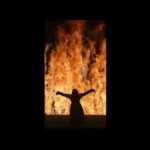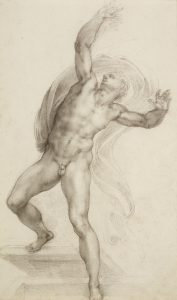
Last summer, Mark Oakley, who was at that stage still Canon Chancellor of St Paul’s Cathedral before his move to Cambridge, invited me to the cathedral to see the two Bill Viola installations/films there. ‘Martyrs: Earth, Air, Fire, Water’, was installed in the cathedral in 2014. Set across four vertical plasma screens, it depicts four individuals being martyred by the four elements. The work is silent and deeply moving.

The second video, ‘Mary’, was installed in the cathedral in 2016, and is a celebration of women, using depictions of Everywoman. I found both artworks extremely moving, so jumped at the opportunity to visit the Royal Academy last week for their exhibition, ‘Bill Viola and Michelangelo: Life Death Rebirth’.
Despite mixed reviews, the exhibition did not disappoint. The main exhibits were by Bill Viola, but they were accompanied by a number of small drawings by Michelangelo. Both artists, of course, demonstrate the beauty and power of the human body, particularly the male body. Michelangelo’s specific meditations on the Resurrection become, in Viola’s work, celebrations of both transformation and physical rising.


The theme of water is so universally present in these works that it almost appears to be an obsession, but it is clearly a metaphor both for life and also for transcendence. Walking through the semi-darkness, watching the videos, some of which take around a quarter of an hour to play, one is transported into  Viola’s world and receives a glimpse of his spiritual awareness. The cleansing of one’s normal attention also made the Michelangelo drawings that much more striking, as one became conscious of the way in which the artist conveys so much of the important essence of the figures with so few strokes of the brush or pen, whether it be a depiction of Christ’s crucifixion, the risen Christ (pictured right) or the tenderness of a nativity scene.
Viola’s world and receives a glimpse of his spiritual awareness. The cleansing of one’s normal attention also made the Michelangelo drawings that much more striking, as one became conscious of the way in which the artist conveys so much of the important essence of the figures with so few strokes of the brush or pen, whether it be a depiction of Christ’s crucifixion, the risen Christ (pictured right) or the tenderness of a nativity scene.
Before I went into the exhibition, a couple of men in the café told me that they had got round it in 10 minutes. I was therefore surprised to find myself still in the darkened rooms after an hour an a half; and even more surprised to find that the images, and Bill Viola’s meditation on life and transcendence, travelled with me when I left.
Comments closed